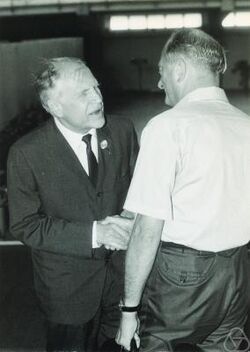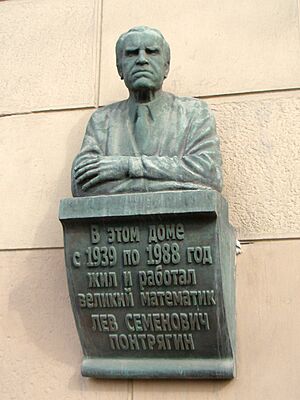Lev Pontryagin facts for kids
Quick facts for kids
Lev Pontryagin
|
|
|---|---|

Lev Semyonovich Pontryagin (left)
|
|
| Born | 3 September 1908 |
| Died | 3 May 1988 (aged 79) Moscow, Soviet Union
|
| Nationality | Soviet Union |
| Known for | Pontryagin duality Pontryagin class Pontryagin cohomology operation Pontryagin's maximum principle Andronov–Pontryagin criterion |
| Scientific career | |
| Fields | Mathematics |
| Doctoral advisor | Pavel Alexandrov |
| Doctoral students | Dmitri Anosov Vladimir Boltyansky Revaz Gamkrelidze Mikhail Postnikov Mikhail Zelikin |
Lev Semyonovich Pontryagin (Russian: Лев Семёнович Понтрягин) was a brilliant Soviet mathematician. He was born on September 3, 1908, and passed away on May 3, 1988. Lev became completely blind at the age of 14. Despite this challenge, he made incredible discoveries in many areas of mathematics. These fields included algebraic topology, differential topology, and optimal control.
Lev Pontryagin's Early Life
Lev Pontryagin was born in Moscow. When he was 14, he had an accident with a primus stove. This explosion led to an unsuccessful eye surgery, and he lost his eyesight completely.
His mother, Tatyana Andreyevna, was a huge help to him. She didn't know math symbols herself. But she would read math books and papers aloud to him. Later, she even worked as his secretary. She made up her own names for math symbols to help him understand. For example, she called the set-union symbol "tails up."
In 1925, Lev started studying at Moscow State University. There, he was greatly inspired by the lectures of Pavel Alexandrov. Alexandrov later became his advisor for his doctoral thesis. After finishing his studies in 1929, Lev began working at Moscow State University. In 1934, he joined the Steklov Institute of Mathematics in Moscow. He later became a vice president of the International Mathematical Union in 1970.
Amazing Math Discoveries
Lev Pontryagin worked on duality theory for homology when he was still a student. He helped create the basic ideas for the abstract theory of the Fourier transform. This is now known as Pontryagin duality. Using these ideas, he solved a part of Hilbert's fifth problem in 1934. This problem was about abelian groups.
In 1935, he was able to figure out the homology groups of certain Lie groups. He later said this was his greatest achievement.
Along with another mathematician named René Thom, Pontryagin is seen as a co-founder of cobordism theory. They both discovered a key idea for this theory. They found that "framed cobordism" and "stable homotopy" are basically the same. This led to the creation of characteristic classes around 1940. These classes were designed to disappear on a manifold that is a boundary.
In 1942, he also introduced special math operations. These are now called Pontryagin squares. In another area of math called operator theory, there are also special spaces. These are called Pontryagin spaces.
Starting in 1952, Lev Pontryagin began working on optimal control theory. His maximum principle is a very important idea in modern optimization. He also came up with the idea of a bang–bang principle. This describes situations where a control is either at its strongest positive or strongest negative setting.
Pontryagin wrote several important books and popular math textbooks.

Many students learned from Pontryagin. Some of his notable students include Dmitri Anosov, Vladimir Boltyansky, Revaz Gamkrelidze, and Mikhail Postnikov.
Want to Learn More?
- Andronov–Pontryagin criterion
- Kuratowski's theorem (also called the Pontryagin–Kuratowski theorem)
- Pontryagin class
- Pontryagin duality
- Pontryagin's maximum principle

